Kiehl's Nightly Refining Micro-Peel Concentrate is supposed to be a gentle exfoliant that can be used everyday, and is safe for sensitive skin. It's meant as a night treatment, rather than a day product. Kiehl's also recommends that the product be used after toner, but before serum. And for those who are familiar with the old Kiehl's Overnight Biological Peel, I was also told that the Nightly Refining Micro-Peel Concentrate would be replacing this product, and the Overnight Biological Peel will be discontinued.
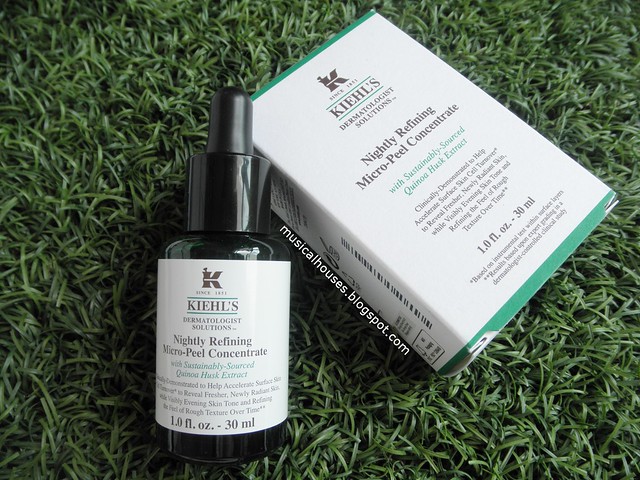
Kiehl's Nightly Refining Micro-Peel Concentrate: A gentle but effective peel you can use everyday
Of course, since this is a peel product, we'll have to answer lots of questions: What's the exfoliating agent? Is it really quinoa seed extract? And is this really a gentle but effective peel? And how does it compare to the old Overnight Biological Peel? We'll be answering those questions, and of course, to do that, we'll start at the ingredients list. Of course, this is going to be a pretty long review, so make yourself comfortable while you read this, and off we go!
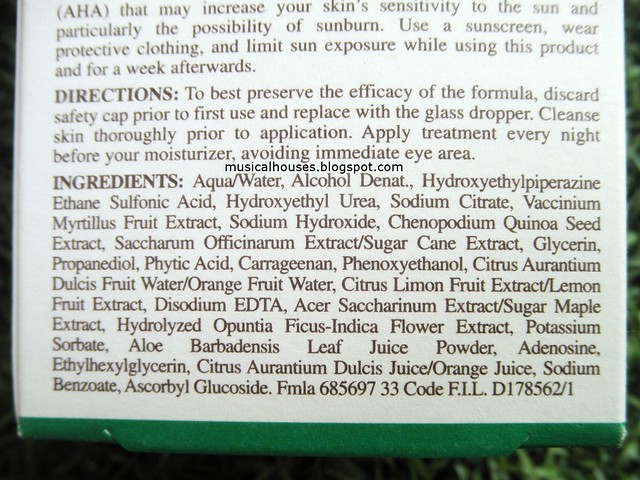
Kiehl's Nightly Refining Micro-Peel Concentrate Ingredients
The ingredients in the Kiehl's Nightly Refining Micro-Peel are Water, Alcohol, which is probably here as a solvent or penetration enhancer, and Hydroxyethylpiperazine Ethane Sulfonic Acid, which is usually used as a buffering agent used to adjust the pH in cosmetics. Then there is a humectant (Hydroxyethyl Urea), and after that we hit Sodium Citrate, which is a preservative in the product. So we know at this point that we've looked at the main ingredients that make up the bulk of the product.
The rest of the ingredients include more plant extracts and other plant-derived ingredients, including Quinoa Seed Extract (Vaccinum Myrtillus Fruit Extract, Chenopodium Quinoa Seed Extract, Sugar Cane Extract, Phytic Acid, Orange Fruit Water, Lemon Fruit Extract, Sugar Maple Extract, Hydrolyzed Opuntia Ficus Indica Flower Extract, Orange Juice), which would be quite in line with Kiehl's focus on including natural and plant-derived ingredients in its products.
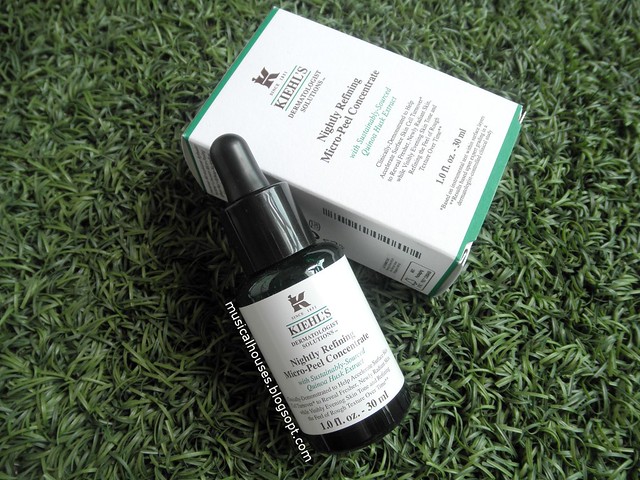
Kiehl's Nightly Refining Micro-Peel Concentrate: A variety of plant extracts offers some supplemental exfoliating benefit
Interestingly enough, a mixture of some of these ingredients (Vaccinium Myrtillus Fruit/Leaf Extract, Saccharum Officinarum (Sugar Cane) Extract, Citrus Aurantium Dulcis (Orange) Fruit Extract, Citrus Limon (Lemon) Fruit Extract, Acer Saccharum (Sugar Maple) Extract) are sold blended together by Active Concepts LLC, a specialty supplier of plant ingredients for skincare formulations, as a blend calledACB Fruit Mix. According to the supplier, ACB Fruit Mix is a blend of "natural AHAs", and is advertised as a moisturizing, but still exfoliating product, "capable of improving moisturization while simultaneously increasing the production of structural components, such as collagen and glycosaminoglycan, as well as reversing cutaneous atrophy".
Lastly, rounding out the ingredients lists are small amounts humectants (Glycerin) and a couple of antioxidants (Adenosine, Ascorbyl Glucoside), as well as more functional ingredients pH adjusters (Sodium Hydroxide), solvents (Propanediol), thickeners (Carrageenan), chelating agents (Disodium EDTA) and preservatives (Phenoxyethanol, Potassium Sorbate, Ethylhexylglycerin, Sodium Benzoate).
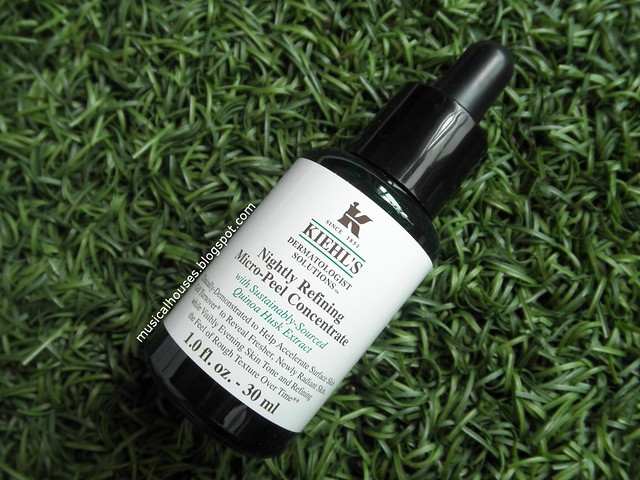
Kiehl's Nightly Refining Micro-Peel Concentrate: The peel doesn't use a typical acid as an exfoliating agent
One thing struck me when I first looked at the ingredients list: there isn't any clear exfoliating agent. Most peels have a very clear exfoliating agent, like an acid of some sort, but the Kiehl's Nighty Refining Micro-Peel didn't seem to have any of that at a first glance. It's possible the blend of plant ingredients has some exfoliating effect, but those ingredients aren't likely to be there in amounts large enough to be sufficient to help exfoliate skin by itself. And while the Quinoa Seed Extract is the featured ingredient, I'm not entirely convinced it plays much role in exfoliation. In fact, CenterChem, a supplier of specialty ingredients, advertises its Quinoa Seed Extract as having "emollient and conditioning properties" rather than exfoliating ones. Certainly emollient and skin conditioning are great for a skincare ingredient to do, but it left me wondering, where is our exfoliant?
Turns out, Kiehl's is using Hydroxyethylpiperazine Ethane Sulfonic Acid, or HEPES, as it is sometimes abbreviated to, as the main exfoliant in the product. In most skincare products, HEPES is often found towards the end of the ingredients list, as it is used in small amounts as a pH adjuster, like most mild acids (Citric Acid being a common example). These are often not used as exfoliating agents because they're usually too mild to act as proper exfoliants.
So why is HEPES being used as an exfoliant? With a bit of digging, I found a patent filed by L'Oreal (the parent company behind Kiehl's) in 2003, for "Aminosulfonic acid compounds for promoting desquamation of the skin" - basically a patent for a group of aminosulfonic acid compounds, of which HEPES is one, to promote skin exfoliation. L'Oreal argues in their patent that "aminosulfonic acid compounds are capable of stimulating the degradation of corneodesmosine, undoubtedly by promoting the activity of proteases (of chymotrypsin-like and trypsin-like type in particular) involved in this process" and thus "constitute excellent active agents for promoting the desquamation of the skin and/or for stimulating epidermal renewal and/or for combating aging of the skin". So evidently L'Oreal believes HEPES, in addition to being used as a buffering agent, can also help exfoliate skin.
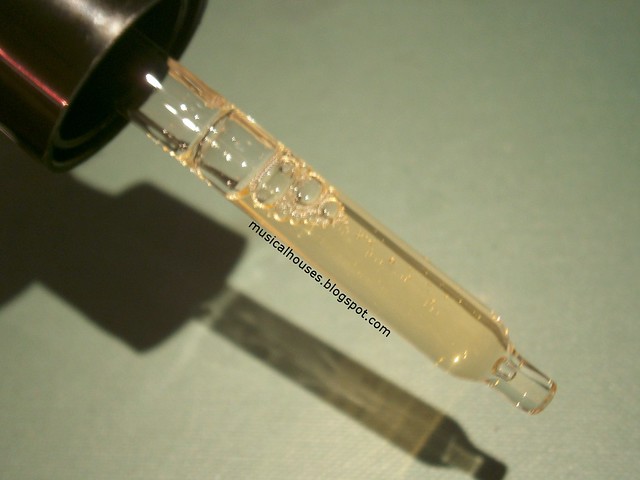
Kiehl's Nightly Refining Micro-Peel Concentrate: HEPES is probably present in percentages of up to 10%
The 2003 patent also gives us a greater insight into the percentage of HEPES, too. The patent cites that "the amount of aminosulfonic derivative...may range...from 0.01% to 50% and preferably from 0.1% to 10% of the total weight of the composition". So I'm guessing the amount of HEPES is probably in the single digits, but close to 10%, since it's the third ingredient on the list. The patent also lists other "pro-desquamating agents" which "act on the radiance of the complexion by promoting turnover and desquamation (keratolytic agents)", which can include "hydroxy acids, in particular α- and β-hydroxycarboxylic acids or β-keto carboxylic acids, and their salts, amides or esters, and more particularly glycolic acid, lactic acid, salicylic acid, citric acid and fruit acids in general, and 5-n-octanoylsalicylic acid". So I guess in this case, in addition to HEPS, the mix of fruit-based exfoliants are probably functioning as the pro-desquamating agent as well to enhance exfoliation.

Ingredients of Kiehl's Overnight Biological Peel, which will be replaced by the Nightly Refining Micro-Peel Concentrate (Image source)
Lastly, since Kiehl's Overnight Biological Peel was going to be discontinued and replaced with the Nightly Refining Micro-Peel, I thought I would do a quick ingredients comparison between the two. I've never personally tried the old Overnight Biological Peel, but digging around, I was able to find the ingredients list for the Overnight Biological Peel online. For what it's worth, the change in the peel is more of an incremental improvement, than a total reformulation. The old Overnight Biological Peel used HEPES as its main exfoliant too, but doesn't have the extra fruit-based acids that the Nightly Refining Micro-Peel. The preservatives are also different - the old Overnight Biological Peel used parabens, but the newer version phased that out. And perhaps the biggest difference is in the base of the peel - the old Overnight Biological Peel used silicones, but the newer Micro-Peel Concentrate removed the silicones, and but added in Alcohol instead, perhaps to enhance the penetration of the peel.
So, after all that ingredients analysis and patent digging, how does the Refining Micro-Peel Concentrate work? Well, the peel uses HEPES as its main form of exfoliant, which makes it a mild exfoliator, as compared to the other typical options on the market (e.g. a glycolic acid peel). The pH of the peel is 4.5, which makes it acidic, but less acidic than a typical acid peel, too. Supplementing HEPSES as an exfoliant are the mix of fruit ingredients, which may potentially help to exfoliate as well, while keeping skin moisturized. So this is formulated to be a mild peel that can be used regularly - and indeed, I was told by Kiehl's that you can indeed use this peel every night if desired.
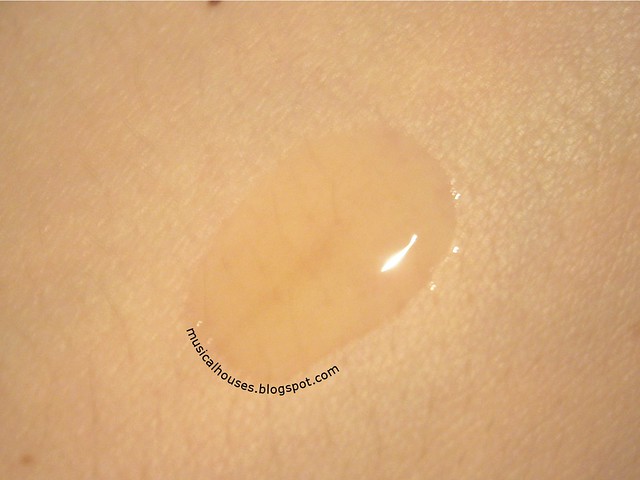
Kiehl's Nightly Refining Micro-Peel Concentrate: A slightly sticky, yellow liquid with a thin texture
So, now that we've looked at the product, how does it actually fare on skin? When applied to skin, it's a yellow liquid with a very light, thin texture. It sinks in pretty well, but if you apply too much, it can end up being slightly sticky on the skin. It also smells like an acid peel or a Vitamin C serum - I'm not too sure how to describe the smell of the product, but if you've ever tried a hardcore Vitamin C serum or a strong acid-based product you'll know what I mean - there's a certain smell that's in the product.
On me, I found that the Micro-Peel Concentrate had a very mild effect, but it seemed to help increase the turnover of my skin somewhat. At the same time, though, there weren't any of the usual side effects that I sometimes got when I used a peel - there wasn't any stinging or redness or sensitivity. I'm used to very strong products, so for me, the lack of side effects was something different. I suppose the trade-off here is that you get milder exfoliation than with a hardcore acid peel, but on the bright side, the side effects are almost non-existent.
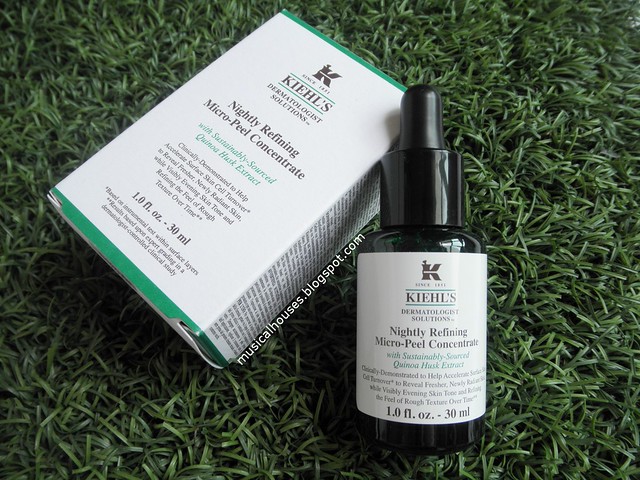
Kiehl's Nightly Refining Micro-Peel Concentrate: Great for those who want a gentle, mild peel, with minimal side effecs
So, would I recommend the Kiehl's Nightly Refining Micro-Peel Concentrate? I think it depends on what you want out of your peel. If you're a hardcore acid junkie and want something really strong, and if your skin can tolerate the stronger products, then this probably might be a bit too mild for your preferences. But if you're looking for a peel that's suitable for sensitive skin, or a first peel to ease you into using acids, or a peel that is mild enough to use everyday, then this would be a good choice to use. If you've tried stronger peels and have found them too harsh on skin, then this would quite likely be a much better option. The formulation is certainly unique, with the use of HEPES and fruit-based acids, so it's certainly something different from the usual AHA or BHA peel. At S$99 for a 30ml bottle, it's not the cheapest product around, but if you're looking for a gentle peel, a well-formulated peel is worth paying for.
| Recommended? | Formulation | Packaging | Ease of Use | Effectiveness |
|---|---|---|---|---|
| Yes, if you want a mild peel | 6/10 | 9/10 | 9/10 | 7/10 |
| The Bottom Line: Kiehl's Nightly Refining Micro-Peel Concentrate uses HEPES as the main exfoliating agent, to provide a gentle peel with minimal side effects. | ||||














Thanks for this very insightful analysis on the ingredients! I'm not always convinced by L'oreal's research, and clearly the marketing on this is more on the quinoa hype. I'm always a scaredy cat when it comes to acids and peels, and i just dabbed a tiny bit of this on a couple of old zit marks, and it stung. Back to physical exfoliants for me! LOL!
ReplyDeleteAwesome review! Thank you for the thorough and insightful information.
ReplyDeleteSuch an insightful post indeed. Would love to try out this peel soon.
ReplyDeleteWOW! Im so glad i found you! You are amazingly knowledgeable and have actually based your review on research and trial! How often do we see that! Rarely! Im super excited now - coz I'm going to have a fun time going through all your previous posts! Bless you!
ReplyDeleteSuch a satisfying, informative read! I'm so used to foraging around through multiple articles, many of which duplicate basic facts, just in order to collate a skerrick of the stuff I'm really interested in. Thanks for telling me everything I need to know about this product. Very refreshing.
ReplyDeleteI'd love to know what micro peels you use and recommend!
ReplyDeleteA study from L'Oreal: Chenopodium Quinoa co-product (CQC) as comparable to salicylic acid in exfoliation
ReplyDeleteOur data shows that CQC reduces SC cohesion, most likely by activating desquamating proteases, without modifying
inter-corneocyte lipid structures. Its excellent safety profile makes it a promising candidate for safe and gentle cosmetic
formulas http://www.congress.loreal.com/2015-wcd/06_RIBAUD_16-9%20ss%20logo.pdf
Fabulous review! I bought this recently and have found such convolud d pseudo science.. I knew this peel was different when I didn't recognize any conventional acids in the ingredients, either. Now I am ready to give the bottle a try! It's feels great on me so far! Beauty junkies unite ;)
ReplyDeleteAwsome rewiev of product, thank you so much for these good informations!
ReplyDeleteHi thanks for this article. Can you help me one thing? So I use the Be ceuticals LAA 25% serum which is a typical vit c serum and I've also recently bought this baby by Kiehl;s. So shall I use the Kiehl's Micro Peel before or after my vit C serum?
ReplyDeleteI don’t know if any of u had any other effects but it sort of darkened my skin. Can this burn the skin? Especially around my eyes and nose area.. I know I’m not supposed to use it in my eyes but my nose though.. help?
ReplyDelete